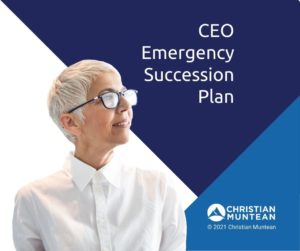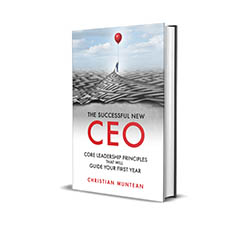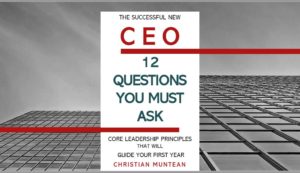Executive Succession Success Tip: Decide What Before Who

 Part 2 of a series on executive succession planning. If you missed Part 1, you can get caught up here.
Part 2 of a series on executive succession planning. If you missed Part 1, you can get caught up here.
Carla was feeling good. The board and management team of Western Manufacturing were taking a short break during their planning retreat. They had just completed an organizational values and vision exercise. It had actually been fun and invigorating. People had felt excited (some were relieved) to discover that there was so much vision in common between most of the people who were involved.
When William, the founder of Western Manufacturing, had announced his retirement, it sent a shock wave through the company. He had built the company up to be a regional leader in their industry. He was a good leader. Thoughtful, generous, and hardworking. It was hard to imagine Western Mechanical without him.
William had also asked Carla to run point on the succession planning process. He said he was too close to the topic. He had made it clear that he thought Carla should consider being his successor. But he felt it was better for him not to try to influence the board’s decision. Since Western Manufacturing had transitioned to being employee-owned, they really needed to be involved.
Carla knew William meant this as a compliment. But the thought of assuming William’s role overwhelmed her. Even though she was vice-chair of the board and COO, she didn’t even know where to start with succession planning. How would she know how to run the entire company?
Ernie, the CFO and board treasurer, had recommended they hire a consultant. They found Adrian, who had done excellent work for a friend of Ernie. At first, Carla had intended to do this in-house, particularly when she saw Adrian’s fees. But now she felt grateful they hadn’t tried to do this on their own.
The values and vision conversation had gone more quickly than Carla had anticipated. As they settled back from their break, Adrian walked up to the front of the room.
The Organizational Chart
“Good work everyone!” Adrian said. “You’ve identified Integrity, Quality Craftsmanship, Reliability, and Creativity as your values.
In terms of your five-year vision, you’d like to “own” the tri-state market and be recognized as national leaders in your industry – specifically in the area of combining environmentally and economically sustainable manufacturing practices. To do this you believe you’ll need to begin to acquire portions of your supply chain and add an additional plant/distribution center that is located in a major shipping hub.”
Heads nodded around the room. The values provided an important framework for decision-making and setting priorities. The specificity of the vision made it easier to imagine and plan.
“You’ll want to regularly refer back to your values and your vision as you plan and make decisions. Ideally, decisions should be in alignment with your values and intended to help move you towards your vision. At a minimum, decisions shouldn’t conflict with either.
But the work is just getting started. Now that you have a picture of what you’d like to build – we need to draft out some sense of how it’ll be engineered. In other words, what will the organizational chart of this larger company look like?”
Stephanie, the HR director, spoke up, “I like org charts. But why build one for something that doesn’t exist?”
“Great question!” said Adrian. “Here’s the reason: Whoever follows William as successor will need to have the ability and drive to build the vision you all have just described. Not only that, but William is a very experienced leader and a gifted engineer.
It’s unlikely that you’ll find someone who has his ability to lead, understands business development, and can help with product design. This isn’t a common combination of skills. It’s likely you may need more than one person to replace him.
You don’t need a CEO who can run the company as it is today. You need a CEO who can build and run the company you’ve described in your five-year vision. To understand what that might look like, it helps to do a ‘back of the napkin’ description of Western Manufacturing in five years.
Not only this, but most organizations stall their own growth by not anticipating their staffing needs. Especially at the management and technical levels. This exercise helps you begin to think about and plan for likely changes that will occur in the foreseeable future.
Keep it simple. Just do a ‘best guess’ exercise about likely new positions or departments, especially at the management level.”
The team understood this. They broke into four different groups for easier discussion. In about half an hour, the groups were ready to present their ideas. It took another half hour to hear each of the presentations and merge the ideas together.
The task proved to actually be pretty simple. Some of it was obvious – the new plant and distribution center would need nearly the same organizational chart as their current one.
Some were a little less obvious: They should be prepared to hire a new senior product engineer and not just assume a new CEO would have this skill. Also, they realized that just over half of their current management team was nearing retirement age. They would need to train or hire for these positions – along with the new ones.
Qualities of a Successor
Overall, they recognized that what they were describing was a more complex company. With operations in different locations, they would need to learn to build an aligned culture. To keep things from getting confused, they would need to ensure consistency in their systems and processes. Last, they would need to be able to attract and train a larger management team relatively quickly.
Without realizing it, what they thought was simply a question about finding a leader, had become a strategy conversation.
“Now that you know what you need to build, you can think about who might fit that role. When thinking about a successor,” Adrian stated, “It’s best to think about the qualities1 you want – as opposed to specific people.
These qualities include obvious topics like areas of expertise and professional background but also ones that are perhaps less obvious like personal experiences, personality and life perspectives that may help with both cultural fit.”
This was helpful for Carla. Initially, she had drawn a blank when trying to consider who could replace William. But now, with their values and vision designed as well as this working organizational chart, it was starting to become clearer what the new executive would need to be able to do.
The team began to describe the qualities they thought were important. Adrian then helped them prioritize the qualities they believed to be most important. These would be given to the search committee.
Ernie leaned over to Carla, “You know, that list of qualities sounds an awful lot like you…” Carla looked at him surprised. Then she thought about it. Maybe she could do this…
Summary
When planning for an executive succession, you need to know what will be led before you can determine who will be able to lead it. Fleshing out the vision with a simple organizational chart exercise is an easy way to start to imagine what those future leadership needs will be.
After you have a good picture of what will be led, you can identify the qualities of who will lead it. Those can be brought to a search committee or recruiter. They will dramatically simplify your search process and help you find the right candidates who are in alignment with your values, vision, and culture.
Stay tuned as Western Manufacturing take the next step in preparing for a successful succession: Stabilizing.
Take good care,
Christian
𝗧𝗵𝗲 𝗕𝗲𝘀𝘁 𝗧𝗶𝗺𝗲 𝘁𝗼 𝗖𝗿𝗲𝗮𝘁𝗲 𝗔𝗻 𝗘𝗺𝗲𝗿𝗴𝗲𝗻𝗰𝘆 𝗦𝘂𝗰𝗰𝗲𝘀𝘀𝗶𝗼𝗻 𝗣𝗹𝗮𝗻 𝗶𝘀 𝘽𝙚𝙛𝙤𝙧𝙚 𝗬𝗼𝘂 𝗡𝗲𝗲𝗱 𝗜𝘁.
Be prepared for a smooth transition in the event of an unplanned emergency succession. My guide will show you step-by-step how to devise your own plan.
Free Leadership Resources
Whether you are a new CEO, thinking of succession or exit, or wanting to strengthen your leadership and your team, I’ve got resources to help:
Enhancing your leadership skills
Are you interested in learning more about becoming a successful CEO? If so, get a free copy of my book The Successful New CEO. Not a new CEO? I’ve been told by “old hands” that they felt any CEO should read this. So, click here to get your copy today.
by “old hands” that they felt any CEO should read this. So, click here to get your copy today.
Let’s connect.
I’m passionate about helping leaders to create workplaces they love going to and increasing the value of the services they offer. My results-oriented approach is tailored to each client’s specific situation and needs. As a leadership coach, I have developed a wealth of resources to help you and your team grow and become stronger.
Weekly Newsletter – sign up to receive my weekly articles addressing critical leadership challenges and issues.
The Leadership Coach Podcast – In my podcast, we explore effective, high-impact, and enjoyable leadership. Subscribe.
There are 𝟭𝟮 𝗰𝗿𝗶𝘁𝗶𝗰𝗮𝗹 𝗾𝘂𝗲𝘀𝘁𝗶𝗼𝗻𝘀 to ask before accepting a new CEO position. Do you know what they are? Instantly download my free e-book here.
Find the value of your company with my free assessment tool: The Value Builder System
The Value Builder System™ is a 13-minute online questionnaire that evaluates your business on the eight factors that contribute more to its attractiveness and value. These factors are scored on a scale of 1-100. Businesses that score over 80 are likely to command 70%-100% higher value than others.
Opportunities
Executive and Leadership Coaching: Do you feel overwhelmed? Are you not getting the results you expect from the effort you are putting in? Do you find yourself facing similar challenges time and time again? Would you like to change specific ways of relating or reacting? If you would like to experience predictable, measurable growth Contact me.
Profitable Exit Strategy Workshop: Are you a business owner or partner? Over 55? Starting to think about exiting your business or active management in the next 3-5 years?
- Curious about what your business might be worth?
- Would you like to discover the specific steps you need to take to increase its value and become highly attractive to a buyer?
- Are you planning on handing it over to family or employees and you want to ensure long-term success?
If so, contact me now
Categories
Get Christian’s Newest Book: Train to Lead

Download my free 10-page eBook:
How To Accomplish More Without Doing More:
Eight Proven Strategies To Change Your Life
Discover how to save eight hours during your workweek-even if you're too busy to even think about it. The resource every maxed out executive needs.

